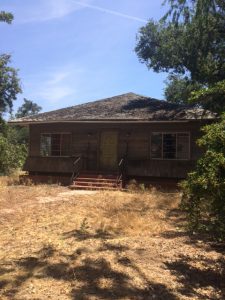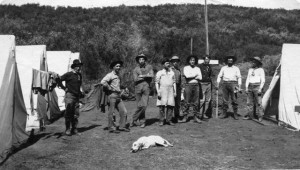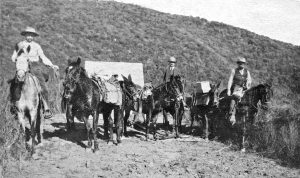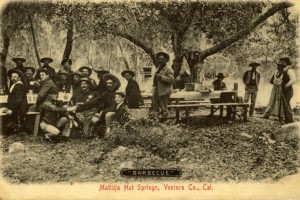The following article was written by Howard Bald and appeared in the March 28, 1973 edition of the Ojai Valley News. It is reprinted here with their permission. Photos have been added by the Ojai Valley Museum. Bald used the same title for many of his articles. So the Ojai Valley Museum added “(No. 4)” to distinguish this particular article.
Reminiscences of Early Ojai (No. 4)
by
Howard Bald
In 1898 the Santa Barbara National Forest (now Los Padres) was created with the headquarters in Nordhoff. Willis M. Slosson was sent out from the east as supervisor. The boundaries extended from Castaic up into San Luis Obispo county and north into Kern county.

Men were recruited from all parts of “back country,” and they were largely homesteaders, cowboys, miners and such. Their pay was $60 per month. They had to own at least two horses and maintain them. Generally the ranger (they were all rangers then) had to provide his own quarters. There were no fringe benefits.
With Nordhoff the national forest headquarters, and since the only means of getting about was via saddle and pack horses, there was a great deal of forestry activity in the valley, that is, mountain men coming and going. A more rugged, hardy, self-sufficient, picturesque group of men would be hard to imagine. Though as a whole they were rather short on formal education, they accomplished a prodigious amount in the way of trail building, and maintaining, investigating mines and homesteads, issuing grazing permits and performing fire suppression.
They were deputy and game commissioners.
Of course there were no telephones at first, no lookout stations, no airplanes or helicopters, or radios, and but few trails. Sometimes a ranger would ride a day or more to get to a fire. The nearest ranger to a fire might recruit a few men – homesteaders, cattlemen or miners, and with just a few simple tools attack the fire.
One wonders now how they accomplished so much with so few men and little equipment, when one hears of the hundreds of men, bombers, fire engines and other sophisticated equipment that is employed to suppress the same fires today -–and at a cost of hundreds of thousands of dollars.
Among some of the more colorful men of that period was Jacinto Reyes, who to this day is a legend among people in the back country, not only for his fire fighting but also for his horsemanship, endurance, rescue work and ability to settle sometimes violent disputes among homesteaders, cattlemen or miners. Then there were his brother Geraldo Reyes, Fred Ortega (father of ex-Ventura postmaster Melito Ortega) and Fred de la Riva. There were what we called in that day “California Spanish.” They were great horsemen and very capable.

My father, George Bald, became one of them in 1903 and until the mid-twenties was chief ranger of this area. Trever Isenberg, Jerome Larmer, Bob Clark, Bob Miller, Bill Herbert, the Leiber brothers, Tom Dunsmore, Gene Johnson were among others of that day I remember. They were what one might call, at that time, “real westerners.”

Sarah McMullen was a nurse who came to take care of Loring Farnum, a semi-invalid who bought our Rinconada ranch (J.D. Reyes and I gave it that name), later the Orchid Ranch, which is now owned by Camp Ramah. She always began the story with: “The worst fright I ever had was being confronted at Mr. Farnum’s front door by three of the awfullest looking men I ever had laid eyes on!” Then there would be a detailed description of the three. “Two were huge, very dark complexioned men with high cheek bones and dark, piercing eyes. The third man was short with a sandy complexion and legs like a pair of ice tongs….”
The refrain would be: “And that was your father….They wore broad brimmed, low crowned hats and red bandanas, and, of course, were unshaven. They curtly asked to see Mr. Farnum. I was trembling so, ” said Sarah, “I could hardly speak when I went back to Mr. Farnum’s room and said there are three of the most terrible men I ever saw who said they want to see you. Mr. Farnum said, “Well, show them in!”
As I pictured the scene, Jacinto and Gerald Reyes and my dad were returning from a week camping in the mountains. They were tired, dusty and, of course, thirsty, and they knew that Mr. Farnum was always generous with the drinks.

